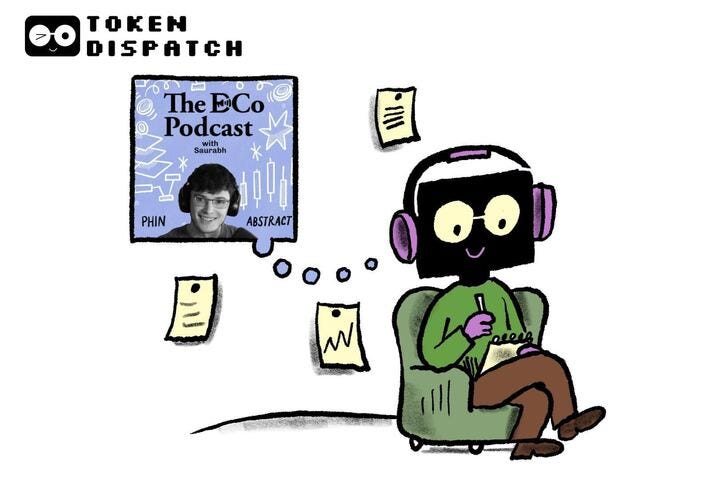Hello
Every week, I sit down and tune into a DCo podcast hosted by Saurabh Deshpande for our partners at Decentralised.co. As part of this weekly ritual, for one hour, I listen to builders solving problems in Web3, then share my takeaways with our retail readers at Token Dispatch.
This week’s reflections focus on the episode featuring Phin, Abstract’s lead marketer.
Want to hear the full marketing guidebook Phin shared? It’s in the episode.
Give it a watch. 👇🏾
Unlock Web3 Insights with Decentralised.co
Long-form stories trusted by the best in Web3. Senior executives from 140+ enterprises trust them to keep them updated on what’s going on in crypto.
Good writing. In-depth conversations. Right in your inbox.
Subscribe to Decentralised.co
At a crypto conference in Bengaluru early this year, I watched a founder demo their blockchain game to a gaming enthusiast, maybe a sixteen-year-old.
The game looked decent. The founder pitched it, flaunting the NFT integration in the game that allows players to own each character of the game via an ERC-721 token.
The kid asked: “Can I try it?”
“Yeah, but first you need to connect your wallet. If you don’t have one, we can set up one using a QR code. And then, all you need is some gas tokens, which I can send you in a few minutes,” the founder said.
The kid said “Thank you” and walked away.
The moment makes a lot more sense now after I watched this conversation with Phin. The founder had a good game. But the crypto wrapping that the founder’s pitch accompanied seemed like a technical puzzle to solve.
Later on the same day, I saw another counter at the conference. “You have to try this, it’s one of the best crypto games out there right now.”
I got to play it. And they were not wrong. It was probably one of the best crypto games. But it was nowhere close to being the best game. Gamers want good games. If you hand them a good game, whether it’s crypto or not, expect them to play it nonetheless.
The game itself was a puzzle game with NFT collectables. It had a clean interface and simple gameplay. Nothing broken. Yet I deleted it within 24 hours, because I had already played some of the best games across various genres, including sports, action, and story-based games. None of those had asked me to download wallets and add gas tokens.
A game won’t see great adoption just for using crypto and blockchain components, and ignoring other fundamentals that make it an interesting one for gamers. Rather, I expect crypto to add value to users’ gaming experience, just as with any other feature in an off-chain game. Think of the in-game buying option. On-chain can surely amplify the gaming experience by allowing seamless in-app purchases using stablecoins and other cryptocurrencies.
“A game doesn’t have to justify that it is a game. A crypto game has to justify why it’s a crypto game. That barrier is the hardest barrier for any team to crack.” Phin said.
This is what I call the justification cost. Your product’s crypto features can’t be its only selling point, not when better alternatives exist off-chain.”
Every crypto product enters the market carrying extra weight. Each of these products is competing for user attention against everything the users already use and trust. A crypto game is competing for the same screen time that Fortnite, God of War, and Call of Duty already command from its users.
A crypto social app competes with Instagram and Discord. A crypto payment solution competes with Venmo and Apple Pay. Users don’t care about technology category. They care about their time and attention, and whether you’re worth it.
This sub-categorisation creates inefficient comparisons through irrational justifications. It drives products to be the best in a specific category while still being mediocre overall. The cost of doing this is often fatal: either poor product adoption or a total failure.
You face the justification cost when you lead with crypto as the foundation of your product, rather than using it as a silent enabler in solving a real problem. You pay the cost when you ask users to understand complex crypto technicalities before they can play a game or make a transfer.
You pay it when your marketing pitch is “this is the best crypto X” instead of “this is the best X”.
What can be done to avoid it?
Stop force-fitting your product through the crypto narrative. Rather, focus on the problem at hand and then see if you need crypto or blockchain infrastructure to solve it more efficiently.
The crypto part need not be the sales pitch. It can just be a small part of the infrastructure that solves the problem.
That’s it for this week’s reflections. I’ll see you next week.
Heading back to playing Valorant,
Prathik
Consider watching the full episode? 👇🏾
Token Dispatch is a daily crypto newsletter handpicked and crafted with love by human bots. If you want to reach out to 200,000+ subscriber community of the Token Dispatch, you can explore the partnership opportunities with us 🙌
📩 Fill out this form to submit your details and book a meeting with us directly.
Disclaimer: This newsletter contains analysis and opinions of the author. Content is for informational purposes only, not financial advice. Trading crypto involves substantial risk - your capital is at risk. Do your own research.






